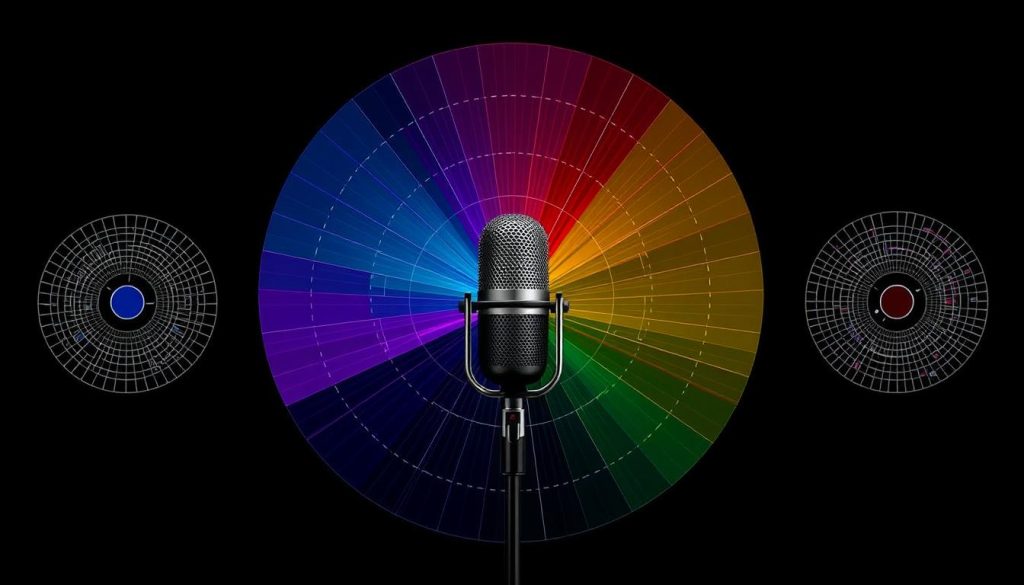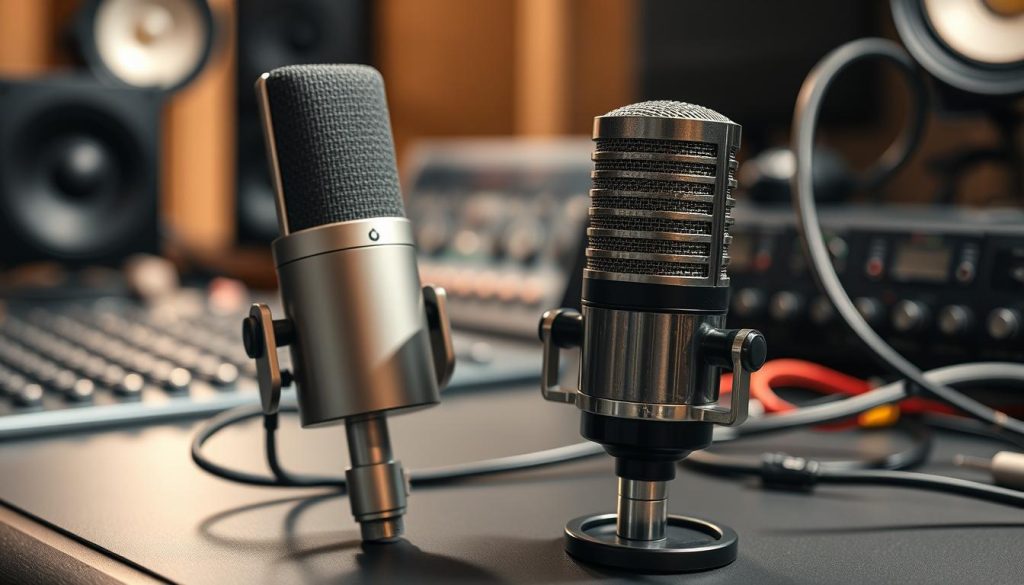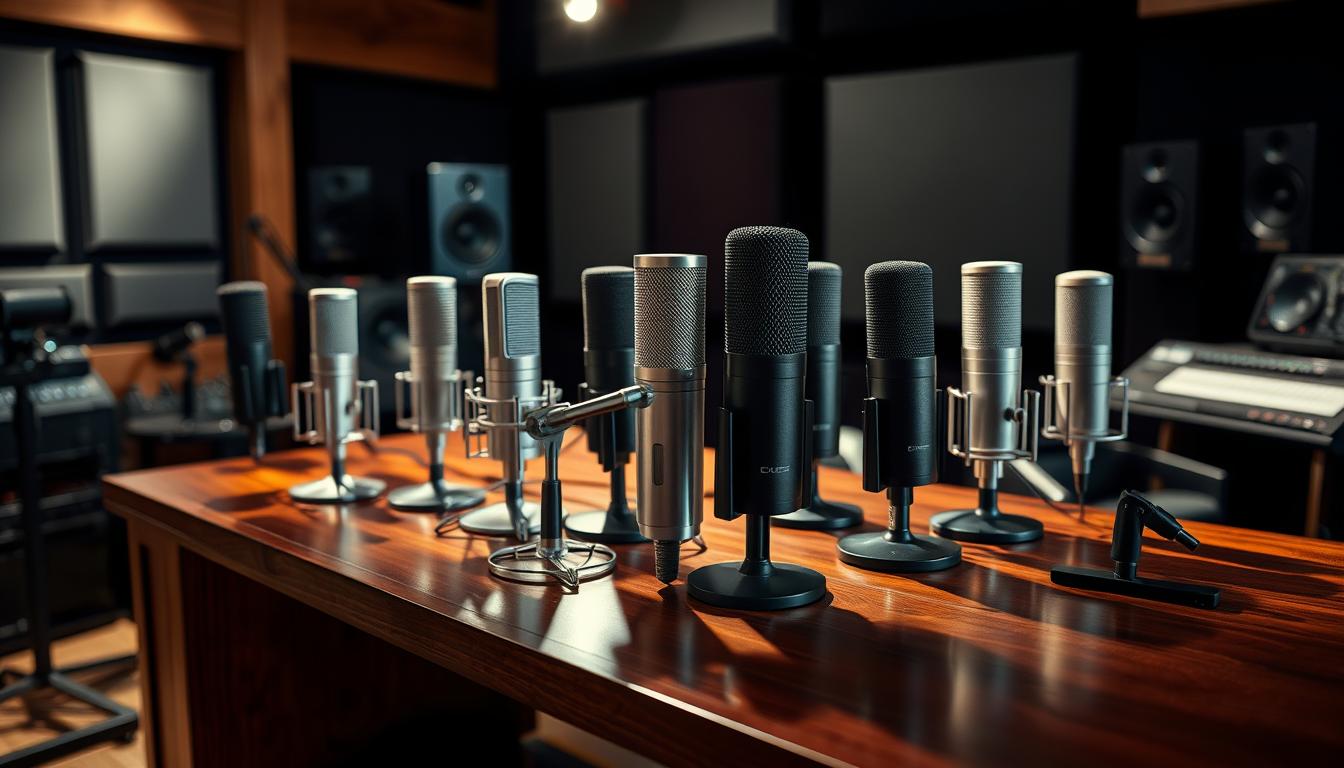As a creator, I know how crucial the right studio microphone is. It’s key for capturing clear audio for music, podcasts, and more. If you’re a pro or just starting, a top-notch studio mic can change your game. This article will guide you to the best studio microphones for pro recording. You’ll learn to pick the right one for your needs.
We’ll look at the types of studio mics and what makes them special. You’ll see why polar patterns matter. Plus, we’ll talk about the best microphones for vocal recording. We’ll also cover USB vs. XLR microphones to help you set up your professional recording space.
By the end, you’ll know a lot about studio microphones. You’ll feel ready to pick the perfect one for your podcast microphones or music. Let’s get into the best studio microphones for pro recording!
What Are the Different Types of Studio Microphones?
There are two main types of studio microphones: condenser mics and dynamic microphones. Each type has its own special features. Knowing these differences helps you pick the right one for your recordings.
Condenser vs. Dynamic Microphones
Condenser microphones are great for capturing detailed sounds. They turn vibrations into an electrical signal. This gives them a wider range of sounds and a higher sensitivity than dynamic mics.
They’re perfect for recording soft sounds like vocals, guitars, and piano. On the other hand, dynamic microphones are tough and can handle loud sounds. They’re great for drums, guitars, and brass.
| Feature | Condenser Microphones | Dynamic Microphones |
|---|---|---|
| Sensitivity | High | Low |
| Frequency Response | Broad | Narrower |
| Durability | Delicate | Rugged |
| Ideal for | Vocals, acoustic instruments | Drums, loud instruments |
Choosing between condenser and dynamic microphones depends on your recording needs. Knowing their differences helps you pick the best one for your project. This choice can improve your recordings.
Importance of Polar Patterns in Studio Microphones

Professional studio microphones rely on polar patterns for top-notch recordings. These patterns show how the microphone picks up sound from different directions. This is key for getting the sound just right.
Cardioid Polar Pattern
The cardioid pattern is a top pick for recording vocals. It has a heart shape and focuses on sound from in front. It ignores sounds from the sides and back. This helps capture the main sound and cut out background noise.
Supercardioid and Hypercardioid Polar Patterns
For even better sound control, supercardioid and hypercardioid patterns are used. They catch sound from a very narrow area. This is great for recording specific sounds or vocals without background noise.
Knowing about polar patterns is key for pro recordings. Picking the right pattern and placing the mic right gets you clear, focused sound. This is true for vocals, instruments, or any sound you’re recording.
studio microphones for Recording Vocals
Professional studios use condenser mics to get clear vocal recordings. These mics catch every detail of the voice. They make your vocals sound clear and lift the quality of your recordings.
The Rode NT1, Shure SM7B, and AKG C414 XLII are top choices for recording vocals. The Rode NT1 gives a clear sound and is quiet. It works well for vocals and acoustic instruments.
The Shure SM7B is a classic mic with a warm sound and great noise blocking. For top-notch vocal quality, the AKG C414 XLII has many settings for different recording needs.
Choosing the right studio microphones for vocals is key for better recordings. Condenser mics for vocals bring out the voice’s emotion and depth. They make your vocals stand out. Whether you’re a pro or a home studio fan, finding the best mics for vocal recording can change your music.
Connectivity: USB vs XLR Microphones

Choosing between USB and XLR microphones is key for a pro recording studio. Each has its own benefits. Knowing the differences helps you pick the right one for your needs.
USB microphones are easy to use. They plug right into your computer’s USB port. This makes them great for home studios and creators. They’re also more affordable for starting in professional audio.
XLR microphones need an audio interface or mixer to work. This might seem like a step back, but it’s not. XLRs send balanced, high-quality sound. They’re the top choice for serious recording setups needing perfect sound.
Choosing between USB and XLR depends on what you need, your budget, and the quality you want. USB is easy and budget-friendly. XLR is for top-notch quality and flexibility.
Knowing the good and bad of each option helps you pick the best microphone for your needs and workflow.
Top Studio Microphones for Professional Recording
Finding the right studio microphone is key for top-notch audio in professional settings. The Rode NT1 gives you clear, detailed sound. The Shure SM7B offers a warm, natural tone that’s a favorite in the industry.
The AKG C414 XLII is great for any recording job. It has many settings to fit your needs. Whether you’re in a pro studio or recording at home, this mic will help you get amazing sound.
Knowing about different microphones, their patterns, and how they connect helps you pick the best one. This way, you can make your recordings sound amazing.

